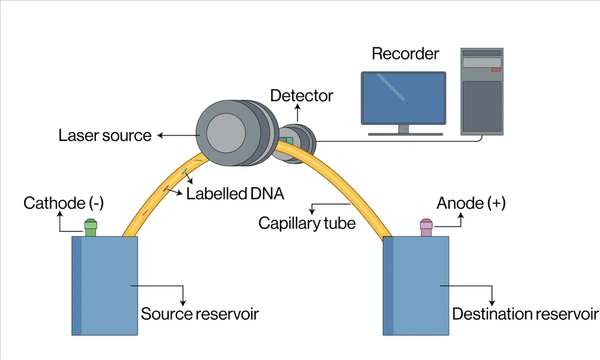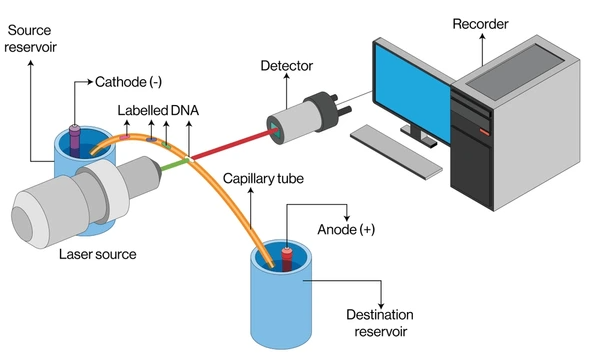
Capillary electrophoresis (CE) is a highly efficient analytical separation technique used in chemistry, biotechnology, and pharmaceuticals to separate charged particles based on their size and charge. This article explains the fundamental principles of capillary electrophoresis, its various techniques, and the wide range of applications that make it a powerful tool in modern analytical science.
What is Capillary Electrophoresis?
Exploring the next big breakthroughs in battery tech? Eureka Technical Q&A connects you with industry experts who can break down emerging materials, performance metrics, and commercialization challenges—helping you understand which battery technologies are truly positioned to disrupt the market.
Capillary electrophoresis (CE) is an advanced analytical technique that separates ions and molecules in an electric field within a narrow capillary tube filled with electrolyte solution. Charged particles move based on their electrophoretic mobility, allowing precise separation according to their size-to-charge ratio.
The origins of capillary electrophoresis can be traced back to the early development of electrophoresis in the 1930s by Arne Tiselius. Over the years, advancements such as the use of fused silica capillaries in the 1980s significantly improved the technique’s performance and popularity . Today, scientists widely use CE to separate and analyze various compounds, including peptides, proteins, and nucleic acids.

Basic Principle of Capillary Electrophoresis
The principle of capillary electrophoresis relies on two main forces:
1. Electrophoretic Mobility
Charged particles move through the capillary under the influence of an applied electric field. Smaller and highly charged ions migrate faster than larger or less charged particles.
2. Electroosmotic Flow (EOF)
EOF is the bulk flow of the liquid inside the capillary caused by the electric field. It moves all species, regardless of charge, toward the cathode, affecting the overall migration time.
Factors Affecting Separation:
- Charge of the molecule
- Size of the molecule
- Capillary length and diameter
- Buffer composition and pH
- Voltage applied
- Temperature
Components of a Capillary Electrophoresis System
- High-voltage power supply (up to 30 kV)
- Narrow-bore capillary (20–100 µm inner diameter)
- Buffer reservoirs (electrolyte solutions)
- Sample injection system
- Detector (UV, fluorescence, mass spectrometry)
- Data acquisition system
Types of Capillary Electrophoresis Techniques

1. Capillary Zone Electrophoresis (CZE)
- Separates ions purely based on charge-to-size ratio.
- Most commonly used CE technique.
2. Capillary Gel Electrophoresis (CGE)
- Uses polymeric gel inside the capillary to separate large biomolecules like DNA or proteins.
3. Micellar Electrokinetic Chromatography (MEKC)
- Separates both charged and neutral species using surfactants forming micelles.
4. Capillary Isoelectric Focusing (CIEF)
- Separates amphoteric substances like proteins based on their isoelectric point (pI).
5. Capillary Electrochromatography (CEC)
- Combines features of CE and HPLC (High-Performance Liquid Chromatography) for improved separation.
6. Capillary Isotachophoresis (CITP)
- Preconcentration method that separates analytes into discrete zones.
Advantages of Capillary Electrophoresis
- High separation efficiency
- Fast analysis times (minutes)
- Requires minimal sample volume
- Low solvent and reagent consumption
- Suitable for both small and large molecules
- Can analyze complex mixtures
- Compatible with automation and online detection (LC-MS, CE-MS)
Limitations of Capillary Electrophoresis
- Limited to ionic or charged species
- Low sensitivity without specific detection methods
- Reproducibility can be affected by capillary surface interactions
- EOF can vary with pH and buffer conditions
Applications of Capillary Electrophoresis
1. Pharmaceutical Industry
- Analysis of drugs and their impurities
- Chiral separations
- Pharmacokinetics studies
- Quality control of raw materials
2. Biotechnology and Protein Analysis
- Peptide and protein separations
- Monoclonal antibody analysis
- DNA and RNA fragment analysis
3. Clinical and Biomedical Research
- Detection of biomarkers
- Forensic toxicology
- Analysis of amino acids and vitamins
4. Food and Environmental Analysis
- Detection of contaminants and food additives
- Analysis of pesticides, herbicides, and pollutants
5. Forensic Science
- DNA profiling and fingerprinting
- Drug screening in biological samples
6. Nanotechnology
- Characterization of nanoparticles
- Analysis of colloidal systems
Detection Techniques in Capillary Electrophoresis
- UV-Visible Absorbance
- Fluorescence Detection
- Conductivity Detection
- Electrochemical Detection
- Mass Spectrometry (CE-MS)
Each detection method enhances sensitivity based on the nature of the analyte and the matrix.
Application Cases
| Product/Project | Technical Outcomes | Application Scenarios |
|---|---|---|
| CE-SDS Genentech, Inc. | Enhanced resolution, automation, and rapid analysis compared to traditional slab gel electrophoresis for protein therapeutics. | Quality control and characterization of recombinant protein therapeutics in the biotechnology industry. |
| DNA Analyzer Applied Biosystems LLC | Improved color separation accuracy and efficiency in multiplexed runs using internal lane standards for in-situ calibration. | High-throughput DNA sequencing and fragment analysis in genomics research and clinical diagnostics. |
| PA 800 Plus Beckman Coulter, Inc. | Efficient sample injection and separation with conductive capillary tips, ensuring reliable electrical contact and minimizing component dilution. | Protein characterization, DNA sizing, and small molecule analysis in pharmaceutical and biotechnology research. |
| CE-LIF System Agilent Technologies, Inc. | Enhanced resolution of glycan separation using tri- and tetra-hydroxyl quaternary ammonium compounds as resolving agents. | Glycan analysis in biopharmaceutical development and quality control processes. |
| Short Capillary CE Zhejiang University | High-speed separations with various sample injection approaches, including optical-gating and flow-gating injection. | Rapid analysis of small molecules and biomolecules in pharmaceutical and clinical research settings. |
Future Trends in Capillary Electrophoresis
- Integration with Mass Spectrometry: One of the significant trends is the integration of capillary electrophoresis with mass spectrometry (CE-MS). This combination enhances the separation and analysis of complex biological samples, providing high sensitivity and specificity. Recent advancements in instrumentation and methodology have improved the efficiency of CE-MS systems, making them more widely applicable in research and clinical settings.
- Miniaturization and Portable Systems: There is a growing trend towards the miniaturization of CE systems, leading to the development of portable and handheld devices. These advancements enable on-site and real-time analysis, which is particularly useful for field applications such as environmental monitoring and pharmaceutical quality control.
- Chiral Separations: Capillary electrophoresis is increasingly being used for chiral separations, which are crucial in the pharmaceutical industry for ensuring the enantiomeric purity of drugs. Recent advances in chiral selectors and separation modes have improved the efficiency and selectivity of CE for enantiomer separation.
- Automation and High-Throughput Screening: The trend towards automation in CE systems is gaining momentum, allowing for high-throughput screening of samples. This is particularly important in drug discovery and development, where rapid analysis of large numbers of compounds is necessary.
- Application in Proteomics and Genomics: The expanding scope of proteomics and genomics research is driving the demand for CE as a tool for separating and analyzing complex biological samples. CE’s ability to handle small sample volumes and provide high-resolution separation makes it ideal for these applications.
- Use of Nanomaterials and Advanced Coatings: The use of nanomaterials and advanced coatings in CE is emerging as a trend to improve separation performance, particularly for proteins. These materials offer advantages such as reduced protein adsorption and better control of electroosmotic flow.
Conclusion
Capillary electrophoresis stands out as a versatile, efficient, and highly adaptable analytical technique in modern science. From pharmaceutical development to environmental monitoring, CE continues to evolve, offering precise separation solutions for a wide range of applications. Its ability to handle complex samples quickly with minimal resources ensures its growing relevance in both research and industrial settings.
FAQs
Capillary electrophoresis separates ions based on their size-to-charge ratio under the influence of an electric field in a capillary tube.
Electroosmotic flow controls the bulk movement of the solution and affects the migration speed of analytes regardless of their charge.
CE can analyze small ions, amino acids, peptides, proteins, DNA, RNA, pharmaceuticals, and nanoparticles.
CE is faster, uses less solvent, and can achieve higher resolution for charged particles. However, HPLC may offer better sensitivity for non-ionic species.
CE requires charged analytes, careful control of EOF, and specific detection techniques to overcome sensitivity challenges.
To get detailed scientific explanations of Capillary Electrophoresis, try Patsnap Eureka.


